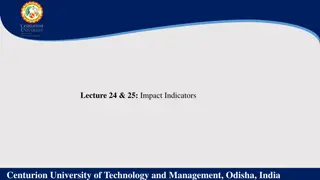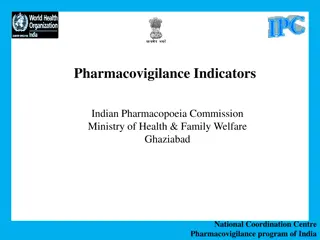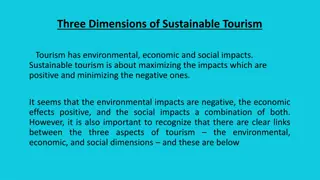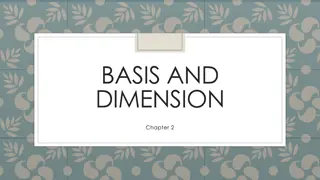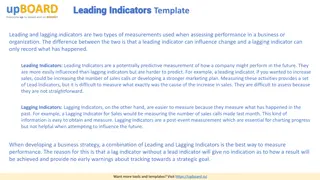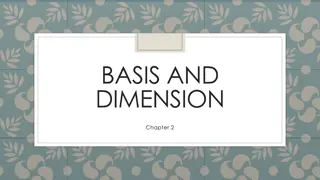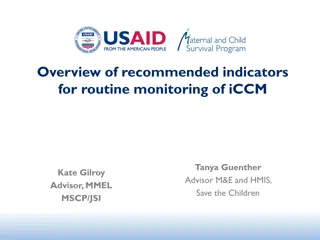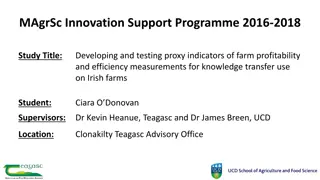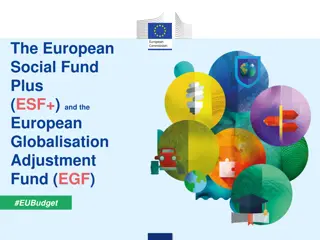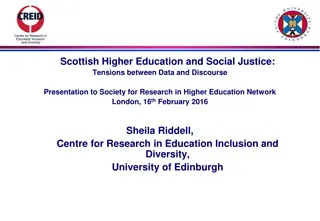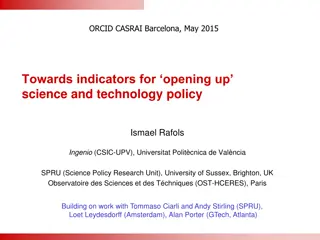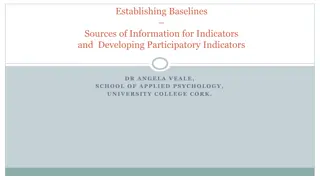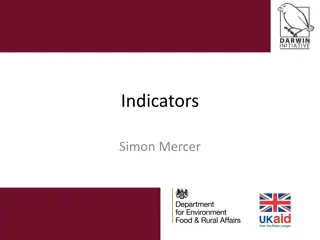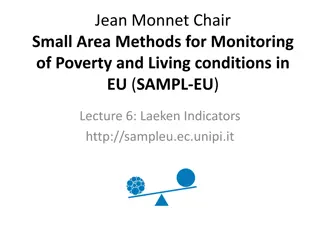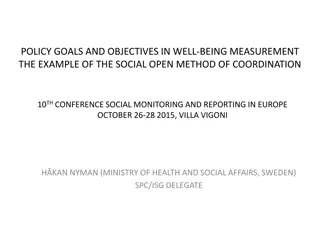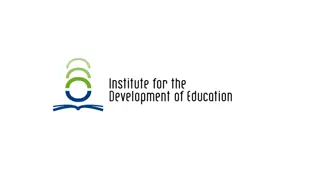Developing Indicators for Social Dimension in European Higher Education
Key findings from a meeting of the Social Dimension working group highlight historical challenges and current disparities in European higher education. The impact of parental background, gender differentiation in disciplines, and lower participation rates among migrants are key areas of concern. The presentation underscores the need for indicators to monitor the implementation of principles and guidelines aimed at addressing inequities in higher education.
Download Presentation

Please find below an Image/Link to download the presentation.
The content on the website is provided AS IS for your information and personal use only. It may not be sold, licensed, or shared on other websites without obtaining consent from the author.If you encounter any issues during the download, it is possible that the publisher has removed the file from their server.
You are allowed to download the files provided on this website for personal or commercial use, subject to the condition that they are used lawfully. All files are the property of their respective owners.
The content on the website is provided AS IS for your information and personal use only. It may not be sold, licensed, or shared on other websites without obtaining consent from the author.
E N D
Presentation Transcript
Developing Indicators for the Social Dimension Social Dimension working group meeting 1 European Education and Culture Executive Agency 8 July 2021
Presentation 1) Relationship working groups on Monitoring and Social Dimension 2) Key findings on Social Dimension from BPIR 2020 3) Developing indicators to monitor implementation of Principles and Guidelines..
Relationship between the working groups WG Monitoring: WG SD: Stimulate and support implementation Of P & Gs Produce 2024 BPIR Developing evidence / indicators on Implementation of P&Gs
Key Findings from BPIR 2020 Historical perspective: social dimension has not progressed well Inequity remains a strong feature of European higher education, and only a minority of countries have taken serious action to address this Without a pandemic the challenge would have been tough Pandemic has had more severe impact on disadvantaged and vulnerable
Key Findings from BPIR 2020 Impact of parents educational background remains very significant in predicting likelihood of children participating in higher education % of mature students (>30) increasing (10% in 2000 17% 2017) Gender: disciplines very differentiated by gender Migrants: lower chance than native-born population of participating in higher education
Gender: % of women enrolled in higher education (2017) ISCED 7 ISCED 6 Education 78.6 79.4 Health and welfare 76.0 68.7 Arts and humanities 65.2 65.2 Social sciences, journalism and information 64.4 67.4 Business, administration and law 56.4 56.7 Natural sciences, mathematics and statistics 56.0 58.3 Agriculture, forestry, fisheries and veterinary 45.1 61.3 Services 44.0 43.6 Engineering, manufacturing and construction 25.5 33.1 Information and Communication Technologies 17.8 24.2
Measures to support retention and completion of students from under-represented groups 2018/19 Map suggests that few countries have given a high policy priority to supporting students from under-represented groups 0 12 26 12 1 1 - - - - Monitoring the composition of the student body based on gender and at least one other under-represented category during studies and at graduation; Longer-term quantitative policy objectives for the attainment/completion of students from under-represented groups; Top-level measures targeting the retention of students and/or financial incentives for HEIs to improve completion rates; Top-level measures targeting the completion of students from under-represented groups specifically.
Eurydice feasibility study to develop indicators: key principles 1) Stick closely to the spirit of the principles and guidelines. 2) Provide clear conceptual definitions for data collection 3) Seek objective, reliable information
Challenges: 1 level of implementation Principles and Guidelines addressed to both governments and higher education institutions (HEIs) Government strategy and policy measures can be assessed from laws and administrative documentation.. HEI action not possible for Eurydice Network (or BFUG) to monitor directly and systematically
Level of implementation: potential solutions Information about HEIs can be gathered indirectly: through guidelines to quality assurance agencies (ie whether or not they monitor Social Dimension policy implementation in HEIs), or through other bodies tasked to oversee implementation Eurostudent data will also provide information on impact of implementation over time Do you have other ideas for collecting information from HEIs?
Challenges 2: respecting different cultures Ex P&G 4 (data collection) guideline: Within the limits of national legal frameworks, such data collection should provide information on the composition of the student body, access and participation, drop-out and completion of higher education, including the transition to the labour market after completion of studies, and allow for the identification of vulnerable, disadvantaged and underrepresented groups. Some countries will not identify vulnerable, disadvantaged or under- represented groups: but should we value countries that collect data on certain characteristics (eg ethnicity) above those that forbid such collection? (for discussion)
Challenges 3: which characteristics to consider? vulnerable, disadvantaged and underrepresented groups. Many shared groups, while some may be specific to countries/regions -> other Eurydice study opted for a fairly exhaustive list, which also includes Age, Gender, Sexual orientation, Labour market status prior to higher education entry (e.g. unemployed), Non-standard entry qualifications, Residing in a certain geographical area (urban/rural/postcode), First generation, Special educational needs, Migrant or from a migrant background, Ethnicity, Refugee, Religious affiliation, Disability, Socio-economic status, Family background (e.g. single parent or care home upbringing) . Other
Typical Bologna Implementation Report indicators 1) Neutral indicators mapping options used for a particular policy 2) Composite indicators, combining (and valuing) different criteria in policy implementation dark green (all criteria are fully met) light green (most aspects appear in the system) yellow (only some aspects are implemented) orange (systems fulfil only a limited part of the criteria) red (none of the criteria are met) As P&Gs are social dimension commitments, the second approach may be more appropriate, (but this has to be discussed/agreed)
An example: P& G 1: Strategies Principle: The social dimension should be central to higher education strategies at system and institutional level, as well as at the EHEA and the EU level. Strengthening the social dimension of higher education and fostering equity and inclusion to reflect the diversity of society is the responsibility of a higher education system as a whole and should be regarded as a continuous commitment. Guideline 1: Strategic commitment to the social dimension of higher education should be aligned with concrete targets that can either be integrated within existing higher education policies or developed in parallel. These targets should aim at widening access, supporting participation in and completion of studies for all current and future students. Guideline 2: In the process of creating strategies there should be a broad-based dialogue between public authorities, higher education institutions, student and staff representatives and other key stakeholders, including social partners, non-governmental organisations and people from vulnerable, disadvantaged and underrepresented groups. This broad-based dialogue is to ensure the creation of inclusive higher education strategies that foster equity and diversity, and are responsive to the needs of the wider community.
Potential elements for an indicator Strategic commitment demonstrated (evidence has to be produced) Targets related to widening access, supporting participation and completion Stakeholders involved in policy development and dialogue Under-represented, vulnerable and disadvantaged group representatives included in policy development and dialogue -> dark green (all criteria are fully met); light green (3 elements are met) yellow (2 elements) orange (1 element) red (none of the elements)
Some P&Gs not straightforward Ex: Guidance and counselling guidelines: Public authorities should create conditions that enable collaboration between different public institutions that provide counselling and guidance services together with higher education institutions in order to create synergies and omit duplication of similar services... Within a diverse student body, special attention should be directed towards students with physical and psychological health challenges Special focus should be placed on prevention of psychological challenges caused by the organisation of study and students living conditions.. How to assess this?
P & G: Guidance and counselling Step 1: break down services psychological counselling; academic guidance, and careers guidance Who provides the services? Are they available to all students? Do they focus on particular students (students with physical and psychological health challenges). Who is responsible for quality assurance? Are they connected to services in schools or for adults etc Very unlikely that public administrative data will be sufficiently reliable for comparative scorecard indicators..
State of play and future process Questionnaire to Eurydice national units has been sent out.. Data collection to be completed over the summer Early 2022 indicators should be available, and a first picture of where Eurydice countries stand Indicators can be discussed/adapted and proposed for 2024 Bologna Process Implementation Report


